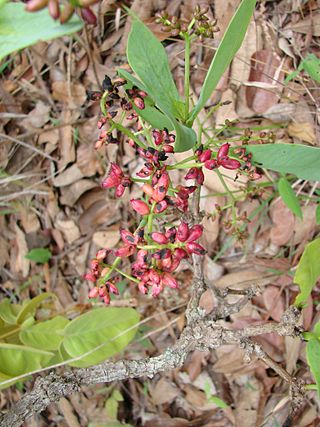
The Cucurbitaceae, also called cucurbits or the gourd family, are a plant family consisting of about 965 species in around 95 genera. Those most important to humans are the following:

Sobralia is a genus of orchids native to Mexico, Central and South America. The plants are more commonly terrestrial, but are also found growing epiphytically, in wet forests from sea level to about 8,800 ft. The genus was named for Dr. Francisco Sobral, a Spanish botanist. The genus is abbreviated Sob in trade journals.

Octomeria is a plant genus belonging to the family Orchidaceae. The genus comprises about 150 species native to the Neotropics, mostly in Brazil.

Myoxanthus is a genus of orchids with about 50 species, widely distributed in Central and South America. This genus is a close ally of Pleurothallis.

Neea is a genus of plants in family Nyctaginaceae from the Caribbean region, Central and South America. Members of the genus are commonly called Nia, Neea, or saltwood.

Renealmia is a plant genus in the family Zingiberaceae. Its members are native to tropical Africa and tropical America. In Peru, fruits and tubers are sources of indigenous dyes. and indigenous medical treatments for leishmania and malaria In Colombia, it is used to treat snakebite. Bracts and leaves can serve as phytotelmata, retaining small quantities of water that offer habitat for other organisms.

Tocoyena is a genus of plant in the family Rubiaceae.

Acianthera is a genus of orchids native to the tropical parts of the Western Hemisphere, especially Brazil. It was first described in 1842 but was not widely recognized until recently. Most of the species were formerly placed under Pleurothallis subgenus Acianthera. This splitting is a result of recent DNA sequencing.

Rodriguezia, abbreviated Rdza. in the horticultural trade, is a genus of orchids. It consists of 49 known species, native to tropical America from southern Mexico and the Windward Islands south to Argentina, with many of the species endemic to Brazil.
Epidendrum tridens is a terrestrial orchid closely allied to E. nocturnum, of which it has often been considered a variety or synonym. For example, Reichenbach 1861 lists Epidendrum tridens(Poepp. & Endl.) Cogn. (1898) as a synonym of Epidendrum nocturnum and Epidendrum nocturnum var. latifoliumLindl. (1837) as a distinguishable variety of Epidendrum nocturnum.

Cyclopogon is a genus of flowering plants from the orchid family, Orchidaceae. It is a fairly large genus distributed widely over much of South America, the Galápagos, Central America, Mexico and the West Indies, with 2 species (C. elatus + C. cranichoides) in southern Florida.

Elleanthus is a genus of flowering plants from the orchid family, Orchidaceae. They are commonly known as tiger orchid. All the species are native to the warmer parts of the Western Hemisphere.

Epistephium is a genus of flowering plants from the orchid family, Orchidaceae. It is native to South America, with a few species in Belize and Trinidad.
- Epistephium amabileSchltr.
- Epistephium amplexicaulePoepp. & Endl.
- Epistephium brevicristatumR.E.Schult.
- Epistephium duckeiHuber
- Epistephium elatumKunth in F.W.H.von Humboldt, A.J.A.Bonpland & C.S.Kunth
- Epistephium ellipticumR.O.Williams & Summerh. (Belize)
- Epistephium frederici-augustiRchb.f. & Warsz.
- Epistephium hernandiiGaray
- Epistephium lamprophyllumSchltr.
- Epistephium laxiflorumBarb.Rodr.
- Epistephium lobulosumGaray
- Epistephium lucidumCogn. in C.F.P.von Martius
- Epistephium matogrossenseHoehne
- Epistephium parviflorumLindl.
- Epistephium portellianumBarb.Rodr.
- Epistephium praestansHoehne
- Epistephium sclerophyllumLindl.
- Epistephium sessiliflorumLindl.
- Epistephium speciosumBarb.Rodr.
- Epistephium subrepensHoehne
- Epistephium williamsiiHook.f.
Palmorchis is a genus of flowering plants from the orchid family, Orchidaceae. It is native to South America, Central America and Trinidad.
- Palmorchis caxiuanensisRocha, S.S.Almeida & Freitas - Pará
- Palmorchis colombianaGaray - Colombia
- Palmorchis deceptoriusVeyret & Szlach. - Colombia
- Palmorchis duckeiHoehne - Brazil
- Palmorchis eidaeDressler - Costa Rica
- Palmorchis guianensis(Schltr.) C.Schweinf. & Correll - Brazil, Venezuela, the Guianas
- Palmorchis imuyaensisDodson & G.A.Romero - Ecuador
- Palmorchis lobulata(Mansf.) C.Schweinf. & Correll - French Guiana, Ecuador, Peru
- Palmorchis nitidaDressler - Costa Rica, Panama
- Palmorchis pabstiiVeyret - French Guiana
- Palmorchis paludicolaDressler - Costa Rica
- Palmorchis pandurataC.Schweinf. & Correll - Ecuador
- Palmorchis powellii(Ames) C.Schweinf. & Correll - Costa Rica, Panama
- Palmorchis prospectorumVeyret - French Guiana, Suriname
- Palmorchis puber(Cogn.) Garay - Brazil, Venezuela
- Palmorchis pubescentisBarb.Rodr. - French Guiana, Suriname, Brazil, Venezuela, Trinidad
- Palmorchis silvicolaL.O.Williams - Costa Rica, Ecuador
- Palmorchis sobralioidesBarb.Rodr. - Ecuador, Brazil
- Palmorchis sordidaDressler - Costa Rica
- Palmorchis trilobulataL.O.Williams - Nicaragua, Costa Rica, Panama, Suriname, Ecuador
- Palmorchis trinotataDressler - Panama

Sarcoglottis is a genus of flowering plants from the orchid family, Orchidaceae. It is widespread across much of Latin America from Mexico to Argentina, with one species extending northward into Trinidad and the Windward Islands.

Cayaponia is the largest genus in the gourd family, Cucurbitaceae, with about 60 species. The plants are referred to as melonleaf. They are common from the southern United States to South America. Some species are also found in western Africa, Madagascar, and Fernando de Noronha, which is about 354 km (220 mi) off the coast of Brazil.














